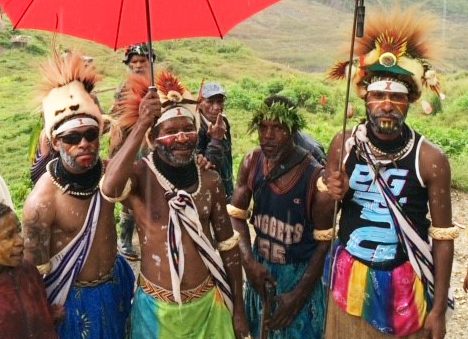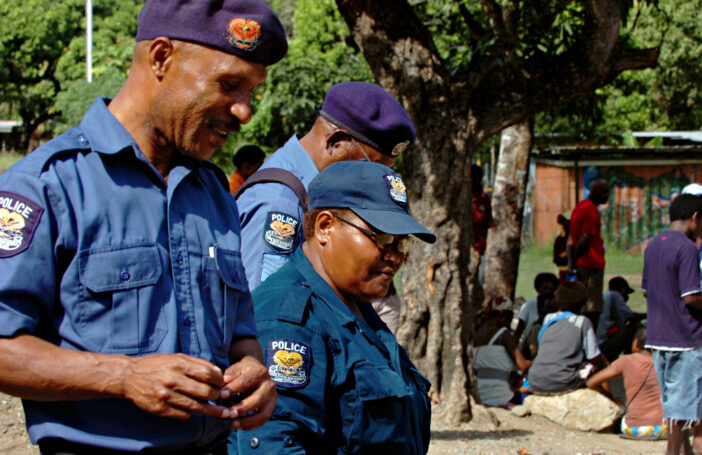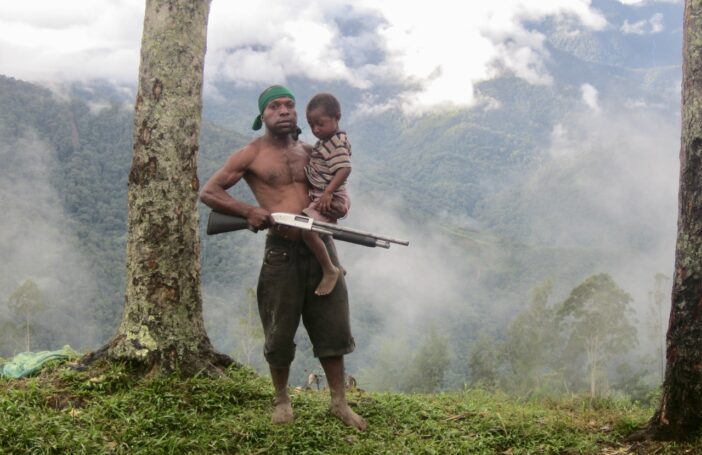A question commonly asked about the inter-group conflict currently occurring in the PNG Highlands is whether or not it represents the continuation of longstanding patterns of violence or is something quite different. The answer, of course, is that it is both. While there are continuities — for instance, violence as a culturally accepted form of conflict resolution — there are also stark differences.
It’s instructive to compare today’s situation with a “snapshot” of inter-group violence in 1984. In that year the Clifford Report was published, arguably the most comprehensive review of law and order in PNG’s post-independence period. The report noted that fighting was “sporadic and geographically limited”, and that fight-related deaths and injuries were “insignificant” compared to other causes of mortality and morbidity. Fighting was not seen to have impeded economic development, with a business survey indicating that it imposed less costs than other types of crime. Participants were able to minimise the personal impact of fighting by removing portable valuables and their families to a safe place, and by limiting weapons to spears and arrows. Most tellingly, the report observed, “[i]t is remarkable that guns are never used.”
A lot has changed in the intervening four decades.
There has been a profound erosion in traditional governance systems. This has taken place at the same time as the introduction and spread of increasingly sophisticated firearms since the late 1980s. The combination of the two has completely altered the conduct and outcomes of contemporary fighting. Anthropologist John Burton claims that “[t]hese weapons have swept the bowmen off the battlefields as surely as the Panzers brushed aside the valiant Polish cavalrymen on the North European Plain in September 1939”. Today’s fighters are armed with M16s, AR15s, self-loading rifles and pump action shotguns. PNG’s extensive and porous borders enable the smuggling of such weapons into the country, while many believe that political and other leaders are involved in their supply to local fighters. The advent of mercenaries and guerrilla tactics has further transformed the ground rules of inter-group conflict, with traditional restraints breaking down and ever-increasing casualties making it difficult to achieve the equivalence integral to older forms of peacemaking.
The human and other costs of contemporary fighting are enormous and growing, including loss of lives, injuries, rape and sexual assault, intergenerational trauma, destruction of gardens, livestock, schools and other public facilities, the withdrawal of government services from affected areas and displacement of local populations. Women are no longer safely removed from the battle zone; rather rape is increasingly being used as a technique of war. Boys are enrolled into battle at a young age, some as young as ten. While still viewed predominantly as a Highlands problem, inter-group conflict has also become a major source of insecurity in other areas, including the National Capital District (NCD). For example, data from an armed violence assessment by the Small Arms Survey found that inter-group fighting was the second most likely form of victimisation in the National Capital District with its large multi-ethnic population.
A pressing question is: how to respond?
A quick historical review shows a pattern of short, militaristic and often brutal state responses, punctuating long periods of state absence. Such interventions rely on emergency measures and special operations, involving paramilitary police mobile squads and defence force personnel working together in designated fight zones. This is extremely dangerous work, with security personnel often outnumbered and outgunned by fighters with extensive local networks and familiar with local terrain. Such interventions are also expensive, requiring transport and sustenance for security forces sourced from other areas. Typically, they are also short-term — a “fire brigade” response intended to extinguish the fire before withdrawal. Following the terrible events in Enga earlier this month, there have been many calls for such a militarised type of response.
Yet there have also been other voices, noting the importance of local leaders and community-led NGOs that shoulder responsibility for dispute resolution and peacemaking in the space left by the largely absent state. Their leadership, cultural knowledge, communications skills and relationships are clearly critical.
Which of these offers the better approach?
Again, the answer is both. There is no doubt that given the evolving technologies of Highlands warfare, there is a need for prompt and firm state security responses to stop fighting and save lives. However, there needs to be a fundamental break with the traumatising ways in which this has historically occurred, and it needs to occur in partnership with local peacebuilders and leaders.
What does this mean?
First, the state response should not come over the top of community responses and then suddenly withdraw, leaving behind traumatised and resentful local populations. Instead, state security agencies need to work together with the network of community leaders, church groups and NGOs often doing extraordinary, though largely invisible, work at local levels. These include the local experts who understand the context and background to particular conflicts and can skilfully navigate through their complexities. Bringing the state back in should not be a temporary, episodic event confined to local crises. State actors need to build longstanding relationships, and to be present even when the media attention goes away.
Second, there needs to be a commitment to bringing courts and other justice services into areas where they often have a limited presence. People need to see that those who perpetrate crimes of violence face consequences for them – if not, it is hard to blame people for seeking to defend themselves by acquiring guns. Justice also needs to be administered to the entrepreneurs and beneficiaries of conflict, and not just to the fighters themselves. A reliable justice system would also enable small disputes to be resolved before they escalate into warfare.
Third, there is a very great need for responding to the problem of trauma caused by long exposure to violence. Government and donor funding is needed to help the population heal, and to stop the cycles of violence being perpetuated by the next generation.
Finally, the underlying problem of guns needs to be acknowledged as a national security priority. Addressing it effectively will require good state-local partnerships.
Building peace in conflict-affected parts of the Highlands will not happen quickly, but it will never happen if there is a recurring see-saw between state and community-led responses. The best prospect for both the stabilisation of ongoing conflict, and the gradual spread of peace, is investment in long-term partnerships between state and community actors.





Tribal fighting is a diabolical problem that for the sake of the country must be addressed. It won’t abate until people in the highlands are presented with meaningful and viable alternatives. Principally a vibrant local economy where traditional land rights are respected. Men need income to meet cultural obligations. Women would wish for peace with good health and education services. All parties would respect a firm but fair and impartial police force.
I worked in the Southern Highlands and what is now Hela province in the mid 1980s at a time when tribal clashes were largely limited to axes, bows and arrows. Mark you people still died followed by inevitable payback. Violence, always a last resort was nonetheless the mark of a man and when called for by the clan leader(s), delivered without hesitation.
But as a government agriculture worker “didiman,” from a foreign country, I was free to travel around the province unhindered while local men “hausman” were weary of walking a kilometre down the road alone for fear of becoming the victim of payback or reigniting a tribal fight with a neighbour. I once drove through warring parties who upon seeing my vehicle approach, parted like the Red Sea and smiled and waved as I drove by.
Within this milieu was a fairly active public service presence of well-resourced agriculture and health workers, teachers, policeman and road service crews with the whole process managed by impartial actors. I think this was a time of hope that held out the promise of a future of economic prosperity, education and health services for all, with impartial policing and relatively peaceful co-existence. Unfortunately, it was not to last.
By the 90’s the major development partners had withdrawn from funding activities across the service sectors. What followed was an inexorable decline in roads and bridge maintenance, government presence and essential services as public servants seeking a better future for their families left.
I believe it is important to note that this process was exacerbated by the politicisation of appointments and economic opportunities. A lack of impartiality, both real and perceived in decision making was a factor in the erosion of local goodwill and the vision of shared futures.
From the mid 1990’s people increasingly returned to resolving problems in the traditional ways, with the addition of a firearms arms race to ensure parity with enemies.
Today, this part of the world is characterised by few services for a population two or three times that of the 1980s. Increasing population pressure over four decades on limited arable resources and a lack of opportunity and human development have all fed into this situation.
Not surprisingly clans have resorted to aligning with one or more armed camps to secure access to resources and young men from a traditional warrior culture in need of money for bride price and status have turned to fighting.
Just how should government re-engage? The issue of impartiality looms large. I agree with the authors that this process must be led by local leadership, who can envision an alternative future and the process brokered by those who are trusted by all parties. And a national government that is seen to commit long term to the very substantial funding needed to create the future that people desire.
Hey, Sinclair, and Miranda!
You avoid as much as I think is possible the common tendency to propose, simply, the opposite of what obtains as the solution. But I don’t think we’ll ever identify a single doable intervention that could work (the last candidate for that was Independence).
But I’ve long been haunted by the example of Afghanistan in the 90s. Riven by politically meaningless conflict among warlords, the country finally found a fairly effective unity and stability through a different kind of force – not the monarchy or the Communists, not foreign occupation or imitation liberal democracy, but religious fervour. The Taliban. We’ll never know how that might have developed, of course, beyond the first 5 years; but we know it happened.
Could – this is the haunting – could something similar arise in PNG? A kind of Christianity, naturally, motivating organisation and good-faith dedication in a “Students” movement…? Kastom, policing, and the construction of Western-modelled institutions never seem to get very far. And the churches and pastors seem far and away the most legitimate authorities, there and elsewhere in Melanesia.
Not a proposed or, I think, wished-for reform, of course! Just a question.
What if this isn’t a seesaw but a long-term trend driven by rural entrapment and increasing impoverishment, the post-Independence reactionary ruralism?
A timely and thoughtful piece that offers a way forward.
The article in the sourcing of weapons from PNG’s security services on ABC news today is also well worth a look: https://www.abc.net.au/news/2024-03-01/png-weapons-aid-australia-united-states-used-in-tribal-fight/103505728